How to Dehydrate Sweet Potatoes
This post may contain affiliate links.
In this post, we’re sharing everything you need to know about dehydrating sweet potatoes! Dehydrated sweet potatoes are perfect for adding to backpacking meals or to have on hand in the pantry.
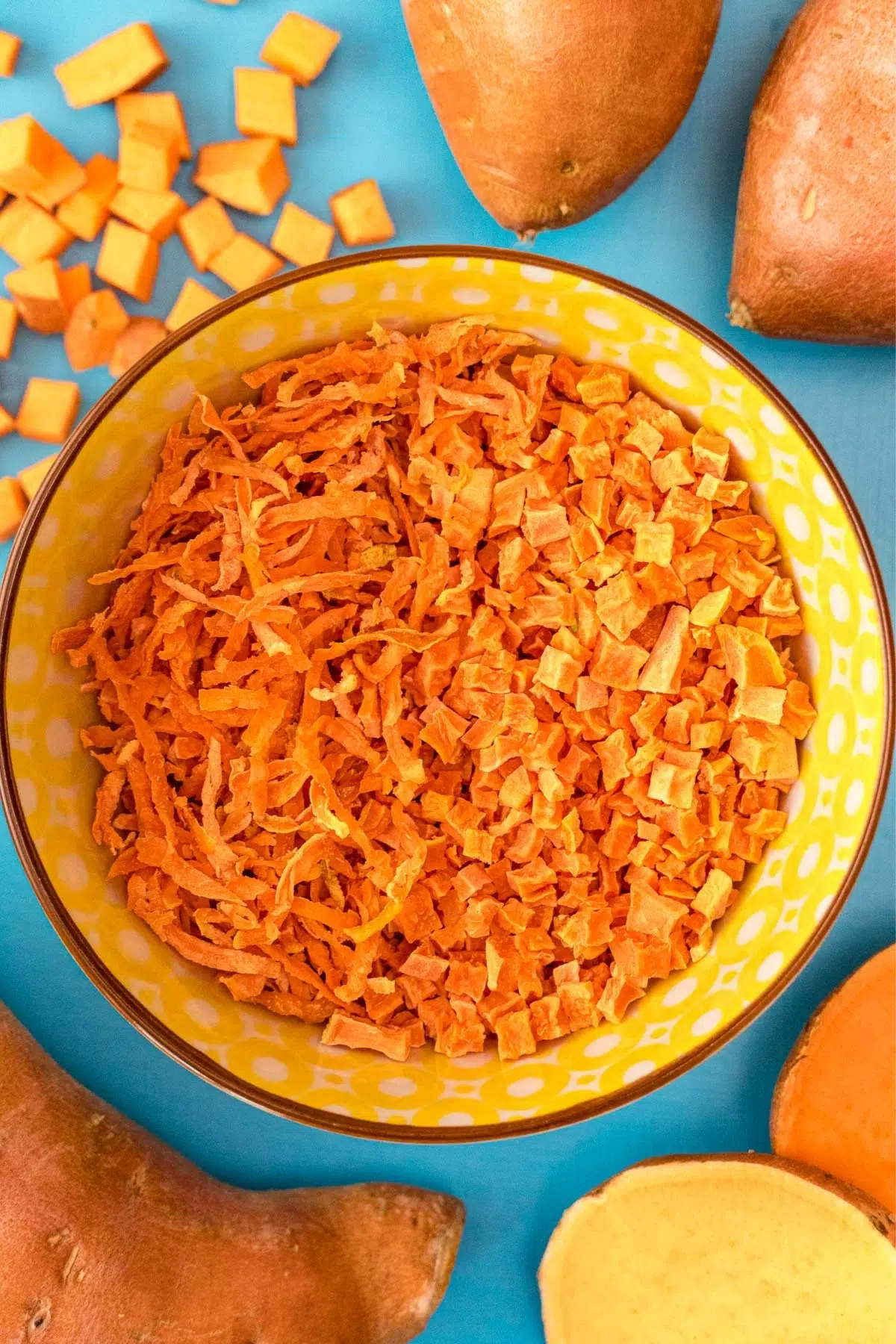
Dehydrated sweet potatoes are a really versatile ingredient that can be included in many lightweight backpacking meals. Not only do they add a distinctive sweet and mild taste, but they can help bulk out a meal that might be light on calories.
Dehydrated sweet potatoes can be fully rehydrated in just a few minutes when added to boiling hot water. Include them in soups, stews, burrito bowls, pasta, curries, or any other meal that is going to be cooked for a little bit in liquid.
Why Dehydrate Sweet Potatoes
The main benefits of dehydrating sweet potatoes are to reduce their weight and speed up their cook time. This combination of attributes is particularly ideal for weight-conscious backpackers, but it’s also something home cooks might find useful as well.

Prepping sweet potatoes for dehydration
Before you start prepping your sweet potatoes, make sure your counters, equipment, and hands are clean & sanitized to prevent contamination, which can spoil your batch down the line.
- Peel sweet potato skins and discard. Wash peeled potatoes under cold water.
- For cubes, aim for pieces smaller than ½ inch. The smaller the pieces, the easier they will rehydrate.
- For shreds, use the large holes of a box grater and shred the sweet potatoes.
- Try to keep the pieces to a uniform thickness to help with even drying.
Pretreating sweet potatoes
Sweet potatoes should be pretreated before being dehydrated, otherwise, they will retain a raw “uncooked” taste when rehydrated.
The most common way to pretreat vegetables is to blanch them for a few minutes, using either steam or boiling water. For sweet potatoes, you can steam blanch them for 2-3 minutes, until nearly tender.
However, our favorite way to pretreat sweet potatoes is to bake them! Baking your sweet potatoes in the oven at 350ºF (177ºC) for about 20 minutes and then fully dehydrating them will yield a much better flavor and texture when they are rehydrated. We did a back-to-back taste test and the baked-then-dehydrated was the hands-down winner over blanched-then-dehydrated.
Sweet potatoes that have been baked will lose some of their nutritional value compared to those that are blanched, but we think the improved taste and texture trade-off is worth it.
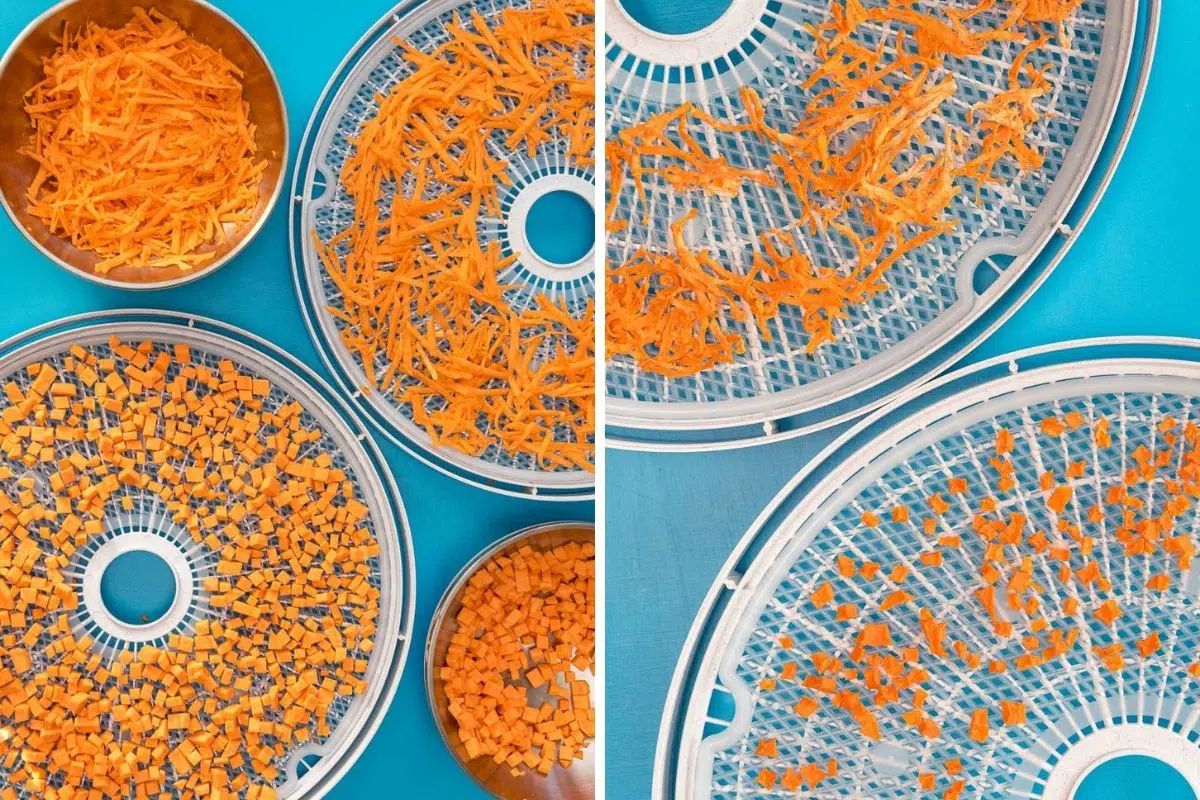
How to dehydrate sweet potatoes
Once your sweet potatoes are prepped, set up your dehydrator and follow these steps:
- Arrange the sweet potatoes out on a mesh liner or parchment paper into an even layer. You don’t want them to be overlapping or touching.
- Dehydrate at 125ºF (52ºC) for 8-12 hours until the sweet potatoes are dry and hard—they should not be soft or squishy
- Depending on your machine, you may need to rotate the trays every so often to promote even drying.
Equipment Spotlight: Dehydrators
If you’re in the market for a dehydrator, we recommend buying one with an adjustable temperature. This will allow you to dial in the drying temp to give you the best results for individual ingredients. The dehydrator we recommend (and use) most often is the COSORI Premium. You can also check out our best dehydrators post for a comparison of all the dehydrators we’ve used and would recommend.
How to tell when sweet potatoes are done
Sweet potatoes should be hard (cubes) and/or brittle (shreds) when they are completely dried. To test, let them cool, then try to squeeze a piece between your fingers. It should be hard when squeezed.
If it is soft, spongy, or you see any moisture squeezing out, then the sweet potatoes need to be dehydrated for longer.
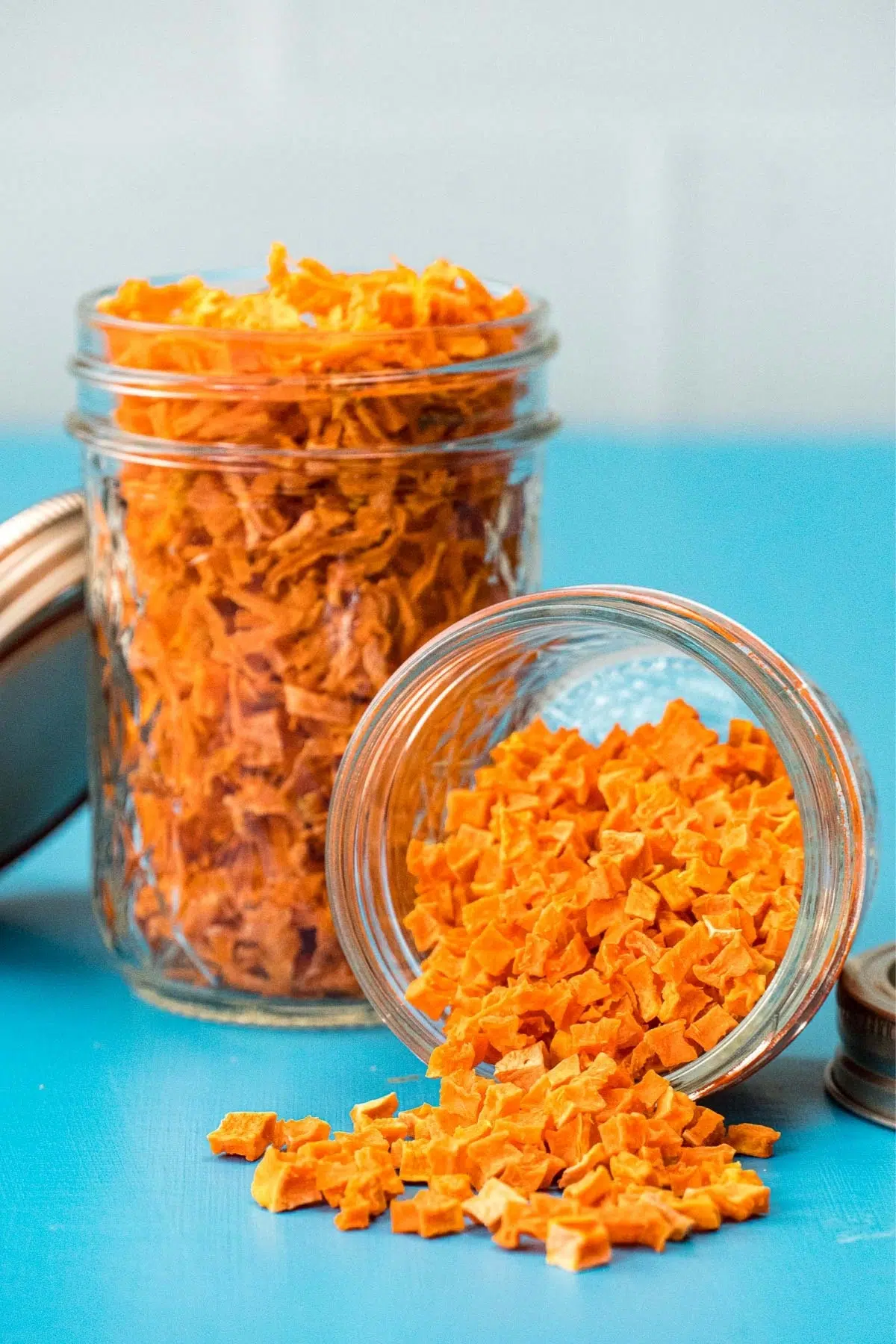
How to store
When properly dried and stored, dehydrated sweet potatoes can last upwards of a year. Here are our tips for storage:
- Let the sweet potatoes cool completely before transferring them.
- Store in a clean, airtight container. For longer shelf life, vacuum seal.
- Use a moisture absorbing desiccant packet if you anticipate opening the container often, or if you live in an area with high humidity.
- Label the container with the date and any other important details
- Place the container in a cool, dark, and dry place—inside of a pantry cabinet works well.
Vacuum sealing tips
We like to store our dehydrated food in mason jars that have been vacuum-sealed using this handheld
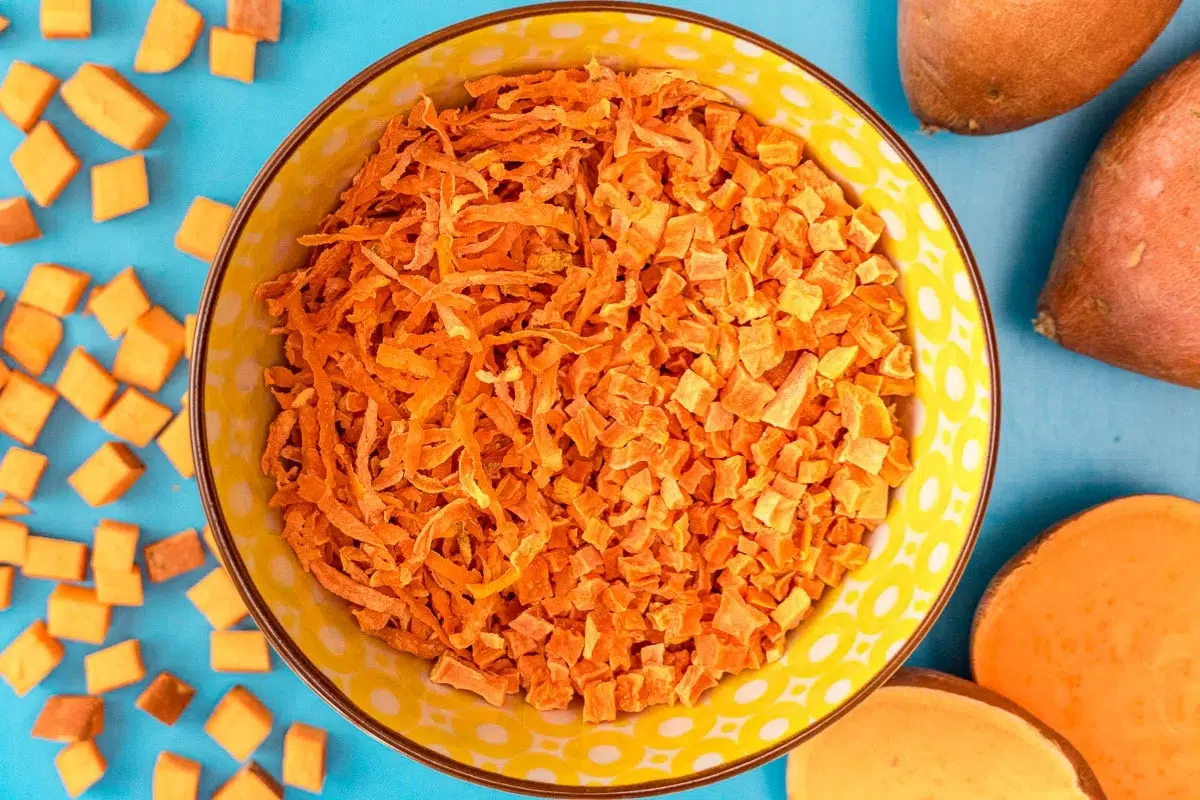
How to use
To rehydrate dried sweet potatoes, add them to boiling water for 10-15 minutes, or use them in meals that are liquidy and will cook for a bit.
Here are a few ideas on how to use dehydrated sweet potatoes:
- Add to soups, stews, chili, or casseroles
- Rehydrate shreds and use them to make Sweet Potato Hash Browns
- Rehydrate shreds and use them in this Sweet Potato Black Bean Burger recipe
- Use them in the following backpacking/camping recipes:
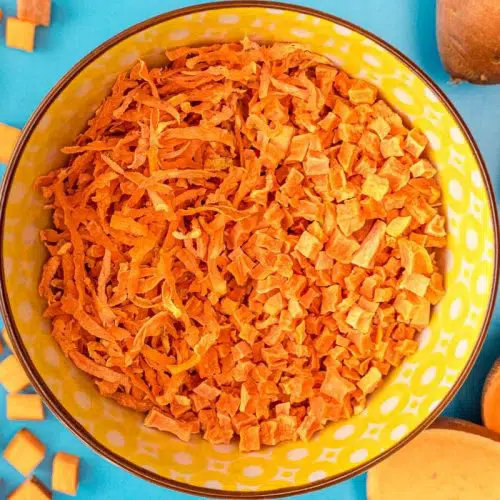
Equipment
- Airtight storage container
- Vacuum sealer (optional)
Ingredients
- 1 lb sweet potatoes, see note 1
Instructions
- Start with clean hands, equipment, and countertops.
- Peel the sweet potatoes, then wash under cold water.
- Cut up the sweet potatoes—For cubes, dice into cubes no larger than ½" inch.For slices, cut into discs ¼" thickFor shreds, use the large holes of a box grater and shred the sweet potatoes
- Blanch or bake the sweet potatoes—To blanch: Add the sweet potatoes to boiling water (or set them in a steamer basket over boiling water) for 2-3 minutes. Drain and rinse under cold water.To bake: Spread the sweet potatoes onto a lined baking sheet and bake at 350°F (177°C) for 20 minutes.
- Arrange the sweet potatoes on dehydrator trays, utilizing a mesh liner to prevent the sweet potatoes from falling through the holes as it shrinks.
- Dehydrate at 125ºF (52ºC) for 8-12 hours until the sweet potato is dry and hard (see note 2).
Storage Tips
- Let the dried sweet potato cool completely before storing.
- Short-term storage: If sweet potato will be consumed within a few weeks, store in a ziptop bag or sealed container on the counter or in a pantry.
- Long-term storage: Condition by loosely packing the dried sweet potato in a transparent, airtight container. Leave it on the counter for a week and check it daily for signs of moisture. If condensation appears, return the sweet potato to the dehydrator (unless there are signs of mold—then, throw out the whole batch). Shake occasionally to keep the pieces from sticking together.
- After conditioning, store in an airtight container in a cool, dark place for up to a year. Vacuum sealing will help extend the shelf life and quality of the sweet potato.
